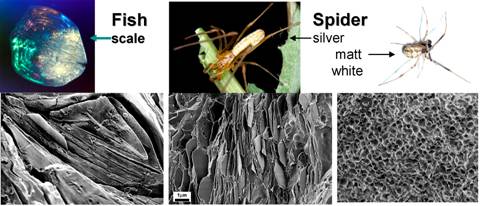
Thanks to advanced techniques, the researchers were able to study the skin and scales intact without damaging their structure. Their findings show that while both fish and spiders used different crystal arrangements, they were both able to evolve effective structures for achieving reflectivity using the same base material (guanine crystals).
The fact that both fish and spiders were able to evolve a unique but equally effective structure for photonic camouflage is particularly intriguing. Says Prof. Peter Fratzl of the Department of Biomaterials at the Max
Planck Institute of Colloids and Interfaces, “It is very surprising that fish and spiders, pertaining to completely
different taxonomic groups, independently acquired through evolution
the ability to generate mirror-like reflections on their skin by
depositing guanine crystals. This suggests that the solution must be
quite efficient and it is, therefore, extremely promising for the
material scientists to try and understand the structural principles of
these photonic crystals working as (colored) mirrors.”

